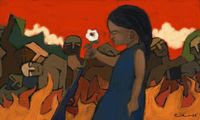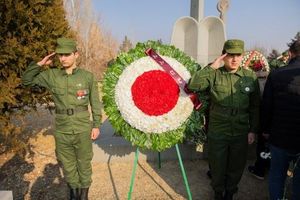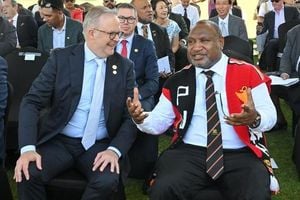On April 22, 2025, the tranquil Baisaran meadow in Pahalgam, Kashmir, was shattered by a brutal terror strike that left 26 people dead and several others injured. The attack, which targeted tourists and forced them to recite the kalma at gunpoint, was a stark reminder of the region’s persistent volatility. According to The Wire, the terrorists’ actions were a calculated attempt to ignite communal tensions and deepen the already fraught Hindu-Muslim divide in the valley.
Omar Abdullah, former Chief Minister of Jammu and Kashmir, was en route from Srinagar to Jammu when the first reports of the attack began to surface. By the time he arrived in Jammu, the death toll had risen dramatically. In an interview for Harinder Baweja’s memoir They Will Shoot You, Madam: My Life Through Conflict, Omar recounted, “I was told one had died and several had been injured but by the time I reached Jammu, I was told 26 had been killed.” He soon received a call from Union Home Minister Amit Shah and returned to Srinagar to meet with him.
The Modi government responded forcefully with Operation Sindoor, deploying the Air Force to strike at the headquarters of Lashkar-e-Taiba and Jaish-e-Mohammed, the groups believed responsible for the carnage. The military escalation was swift, but the aftermath left Kashmiris—once again—grappling with the debris of conflict. “A very dark cloud hovered over Kashmir,” Omar Abdullah reflected, as quoted in The Wire.
In the days that followed, Kashmiris themselves condemned the attack. Unlike previous incidents, this time the local population vocally opposed the violence, showing solidarity with the victims and their families. Yet, as Mirwaiz Umar Farooq observed, this outpouring of grief and unity was barely acknowledged in national media or by top political leaders. “It was not even acknowledged in Prime Minister Modi’s Mann ki Baat,” the Mirwaiz told Baweja. Instead, hardline voices in other parts of India forced Kashmiri students and professionals to return home, further isolating the region.
Himanshi Narwal, who lost her husband in the attack, faced vicious backlash after she publicly urged, “Don’t attack Kashmiris and Muslims.” The streets of Jammu and Kashmir signaled a yearning for peace and stability, but New Delhi’s response, critics argue, has been largely tone-deaf to this rare moment of unity. “Everyone talks about Kashmir but nobody talks TO Kashmir,” Baweja lamented in her book.
The attack also sparked a flurry of accusations in the media, with some suggesting that tourist guides had accessed Baisaran without proper permission. Omar Abdullah, however, categorically dismissed these claims. “Only last year [2024], the current lieutenant governor’s [Manoj Sinha] government issued a tender for Baisaran for three years and made it a ticket destination. The contract was given to a local businessman from South Kashmir, who in turn paid the LG’s government one crore rupee per year for ticketing rights. You don’t offer one crore a year for some place that’s only open for a month. It was open for eight to nine months in the year,” he explained. He further clarified, “There is not a single piece of paper to suggest that written permission or any sort of permission was ever sought. And again, I make the point, Baisaran was bid and sold as a ticketed destination. More than 40,000 or 50,000 people had already visited Baisaran by 22 April. The number could be higher. Now, if it had been opened without permission, was the administration sleeping?”
Amid the turmoil, questions about security failures loomed large. Why was there not a single security officer present at such a popular tourist site? Why was intelligence so scant ahead of the attack? As The Wire pointed out, “Complacency is dangerous. The erstwhile state’s future lies buried, not just under the weight of its past, but also in the uncertainty of its tomorrow.” The absence of violence on the streets, the piece argued, cannot be mistaken for genuine peace or normalcy. The alienation of Kashmir’s population, it warned, still demands a meaningful political initiative.
These events unfolded against a backdrop of growing concern over freedom of expression in the region. On August 5, 2025, the Jammu & Kashmir administration issued a notification forfeiting 25 books, including two by Dr. Sumantra Bose: Contested Lands and Kashmir at the Crossroads: Inside a 21st Century Conflict. The government claimed these works “propagate false narrative and secessionism” and have contributed to “radicalisation of youth in J&K,” The Indian Express reported.
This sweeping ban was immediately challenged by a group of petitioners, including Dr. Bose, retired Air Vice Marshal Kapil Kak, conflict expert Dr. Radha Kumar, and former Chief Information Commissioner Wajahat Habibullah. Their petition, represented by advocates Vrinda Grover, Soutik Banerjee, Devika Tulsiani, Ratna Appnender, and Adil Pandit, argued that the government order failed to specify which content was objectionable. They contended that the order merely reproduced statutory provisions without linking them to the actual books, falling short of the “threshold of a ‘reasoned order’ envisaged by Sec 98 (of the) BNSS.”
On October 1, 2025, the Jammu & Kashmir and Ladakh High Court agreed to hear the petition, with Chief Justice Arun Palli orally directing the formation of a three-judge special bench under Section 99(2) of the BNSS. This section requires appeals against state notification forfeiting printed material to be heard by a special bench. The petitioners argued that such forfeiture provisions “cannot be used to erase the lived realities and people’s histories, as that would amount to an erasure of the nation’s history which violently militates against the people’s right to know.” They further emphasized that “works of history, published through academic rigour, research and thoroughness, are open to be debated, but cannot be erased on the basis of fleeting sensitivities that may get hurt of people incapable of engaging with dissenting or alternate views.”
The stakes are high, not just for the authors and academics whose works have been banned, but for the broader principle of free inquiry and the preservation of historical memory. “Such a blanket ban on historical works is a disservice not only to the right to know of today’s citizenry, but also of the right to know of future generations,” the petition stated. The Supreme Court, which first heard the matter on August 29, 2025, directed petitioners to approach the High Court for expedited consideration.
Meanwhile, the Supreme Court has also weighed in on the broader human rights situation in Jammu and Kashmir. In its ruling upholding the scrapping of Article 370, Justice Sanjay Kishan Kaul recommended the establishment of an impartial Truth and Reconciliation Committee to investigate abuses by both state and non-state actors since the 1980s. “To move forward, wounds require healing. Inter-generational trauma is felt by people. The first step towards healing the wounds is the acknowledgment of the acts of violations done by the state and its actors,” Justice Kaul observed.
As the region stands at a crossroads, experts and former officials have called for a bold political outreach. Former R&AW chief A. S. Dulat suggested that Prime Minister Modi should visit Srinagar and announce the restoration of statehood, while Lieutenant General D. S. Hooda and Lieutenant General Dua have both urged New Delhi to prioritize winning the trust of the people and to consider a phased withdrawal of the army from the hinterland.
Jammu and Kashmir’s future remains uncertain, shaped by the interplay of violence, political inertia, and contested narratives. The events of 2025, from the Pahalgam attack to the banning of books, underscore the urgent need for dialogue, accountability, and a renewed commitment to both security and civil liberties. The last word on the region’s destiny, as many observers note, is still unwritten.




